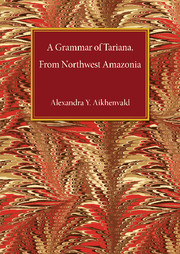Book contents
- Frontmatter
- Dedication
- Contents
- List of tables, schemes and diagrams
- Preface
- Acknowledgements
- Organisation and cross-referencing
- List of abbreviations
- Map
- 1 The language and its speakers
- 2 Phonology
- 3 Word classes
- 4 Nominal morphology and noun structure
- 5 Noun classes and classifiers
- 6 Possession
- 7 Case marking and grammatical relations
- 8 Number
- 9 Further nominal categories
- 10 Derivation and compounding
- 11 Closed word classes
- 12 Verb classes and predicate structure
- 13 Valency changing and argument rearranging mechanisms
- 14 Tense and evidentiality
- 15 Aspect, Aktionsart and degree
- 16 Mood and modality
- 17 Negation
- 18 Serial verb constructions and verb compounding
- 19 Complex predicates
- 20 Participles and nominalisations
- 21 Clause types and other syntactic issues
- 22 Subordinate clauses and clause linking
- 23 Relative clauses
- 24 Complement clauses
- 25 Discourse organisation
- 26 Issues in etymology and semantics
- Appendix. The main features of the Tariana dialects
- Texts
- Vocabulary
- References
- Index of authors, languages and subjects
25 - Discourse organisation
Published online by Cambridge University Press: 05 August 2013
- Frontmatter
- Dedication
- Contents
- List of tables, schemes and diagrams
- Preface
- Acknowledgements
- Organisation and cross-referencing
- List of abbreviations
- Map
- 1 The language and its speakers
- 2 Phonology
- 3 Word classes
- 4 Nominal morphology and noun structure
- 5 Noun classes and classifiers
- 6 Possession
- 7 Case marking and grammatical relations
- 8 Number
- 9 Further nominal categories
- 10 Derivation and compounding
- 11 Closed word classes
- 12 Verb classes and predicate structure
- 13 Valency changing and argument rearranging mechanisms
- 14 Tense and evidentiality
- 15 Aspect, Aktionsart and degree
- 16 Mood and modality
- 17 Negation
- 18 Serial verb constructions and verb compounding
- 19 Complex predicates
- 20 Participles and nominalisations
- 21 Clause types and other syntactic issues
- 22 Subordinate clauses and clause linking
- 23 Relative clauses
- 24 Complement clauses
- 25 Discourse organisation
- 26 Issues in etymology and semantics
- Appendix. The main features of the Tariana dialects
- Texts
- Vocabulary
- References
- Index of authors, languages and subjects
Summary
Here we consider a number of issues related to the organisation of discourse in Tariana. First, we look at the pragmatic basis for the order of constituents (§25.1). Ellipsis is discussed in §25.2. In §25.3 we consider the correlations between the placement and repetition of clausal enclitics and discourse organisation. Then in §25.4 we look at repetition in discourse and at sentence linking strategies. Grammatical properties of narratives and of conversations, and principles of code-switching are considered in §25.5.
Pragmatic basis for constituent order
Constituent order in Tariana is pragmatically based, and has little to do with the marking of grammatical relations. Tariana belongs to ‘pragmatically ordered’ languages for which establishing a ‘basic constituent order’ is an impossible and unproductive exercise -arguments against the universal character of ‘basic constituent order’ were given by Mithun (1987); also see Gildea (2000) for a reappraisal of the concept of ‘basic constituent order’ and a discussion of the limits to its applicability. Tariana shares this property with many polysynthetic languages – such as Cayuga, Ngandi and Coos discussed by Mithun (1987), and most Arawak languages, e.g. Palikur and Baniwa of Içana – as well as languages of other types, e.g. Russian, Czech, Latin, Sanskrit, Dyirbal, Fijian and Jarawara.
- Type
- Chapter
- Information
- A Grammar of Tariana, from Northwest Amazonia , pp. 561 - 593Publisher: Cambridge University PressPrint publication year: 2003



